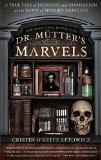Summary | Excerpt | Reviews | Beyond the Book | Readalikes | Genres & Themes | Author Bio
A True Tale of Intrigue and Innovation at the Dawn of Modern Medicine

Critics' Opinion:
Readers' Opinion:
First Published:
Sep 2014, 384 pages
Paperback:
Sep 2015, 384 pages
 Book Reviewed by:
Book Reviewed by:
Poornima Apte
Buy This Book
Mutter loved his time in Paris, but his desire to return to Philadelphia was even stronger. He was twenty-one years old and felt healthier than he ever had in his entire life. He felt like a new man. He had even given himself a new name. He was no longer Thom D. Mutter from Virginia.
He had reinvented himself as Thomas Dent Mütter—with a perfectly European umlaut over the u.
With the last of his money, he purchased a wax model from a shop that specialized in reproductions for doctors. It was the face of Madame Dimanche, the French washerwoman who grew a large, brown horn from the center of her forehead. At first, the old woman hadn't known what to make of the strange brown nub that appeared like an ashy smudge in the center of her head, but she knew to hide it from view, starting a decade-long habit of avoiding eye contact. But the nub grew relentlessly, larger and larger, until it was as thick and dark as a tree branch.
When she finally allowed it to be examined, she followed a chain of doctors that ended with a surgeon who told her he could remove it if she would trust him. She did. And so it happened the surgeon—practiced in this new art of les opérations plastiques—who promised her relief was able to actually deliver it. How happy she was to walk down the streets, her head unhidden. How thrilling it was to feel the wind kiss her bare face.
Mütter purchased a replica of Madame Dimanche's presurgery face, her long, thick horn still intact. And on the long journey back to America, he took it out often, the sea bucking the boat beneath him. He took out her face and stared into it. In it, he saw his future.
CHAPTER TWO
THE CITY OF BROTHERLY LOVE
THE PHYSICIAN SHOULD BE AN AMBITIOUS MAN
To say to a young man "be not ambitious," is to say to him live the life of a drone.
If ambition were a sin, is it probable that a wise Creator would have endowed nine-tenths of his people with it?
The love of praise is so congenial to our nature, and so powerful a spur to every undertaking, that the moral world would be a chaos without its animating influences.
It is like the sun; it gives life and heat to all around.
Philadelphia in the early 1800s was an easy place to die.
The simplest thing could end your life: a broken bone from a fall, a leg gouged by a loose nail, a hand burned by a pot of boiling soup. In a time before antibiotics, infections could ravage a body in days. You could die from allergies. You could die from asthma. You could die from a single rotten tooth.
The food you ate and the water you drank could kill you just as easily as the guns that were bought and sold without regulation. Of course, there was cancer and diabetes, gout and heart disease. There was murder and suicide and accidental drownings, as well as executions by city and state.
Infectious diseases ran rampant through populous cities like Philadelphia, wreaking havoc on everything they touched.
There was smallpox, spread simply by human interaction. It caused the body to burst into blisters, lesions, and scabs, affecting adults and children equally and brutally. If you were lucky enough to survive it, the scars left behind—including sterility—could haunt you the rest of your life.
There was yellow fever, which no one knew was spread by mosquitoes and which earned its name by turning its victims yellow, before forcing them to bleed from the eyes and mouth and erupt with the black vomit of partially digested blood.
In 1793, yellow fever struck a rain-soaked Philadelphia so hard that the entire government shut down. Once symptoms were seen, the infected person was all but abandoned by friends and family. To protect their own patients, the Pennsylvania Hospital and Almshouse refused to receive yellow fever victims, forcing ailing citizens to eventually die alone in the streets. It became such a problem that local authorities annexed a circus ground on the outskirts of the city as a "depository [for] victims of the plague who had nowhere to go and nobody to care for them." The city's most prominent physician, Dr. Benjamin Rush, advised that all his patients leave the city at once, and anyone forced to remain should immediately engage in "heroic bleeding and purging." Rush's advice only caused more death. By the end of the disease's reign, more than one-tenth of the city's entire population was dead.
Excerpted from Dr. Mütter's Marvels by Cristin O'Keefe Aptowicz. Copyright © 2014 by Cristin O'Keefe Aptowicz. Excerpted by permission of Gotham Books. All rights reserved. No part of this excerpt may be reproduced or reprinted without permission in writing from the publisher.





The House on Biscayne Bay
by Chanel Cleeton
As death stalks a gothic mansion in Miami, the lives of two women intertwine as the past and present collide.

The Flower Sisters
by Michelle Collins Anderson
From the new Fannie Flagg of the Ozarks, a richly-woven story of family, forgiveness, and reinvention.

The Funeral Cryer by Wenyan Lu
Debut novelist Wenyan Lu brings us this witty yet profound story about one woman's midlife reawakening in contemporary rural China.
Your guide toexceptional books
BookBrowse seeks out and recommends the best in contemporary fiction and nonfiction—books that not only engage and entertain but also deepen our understanding of ourselves and the world around us.